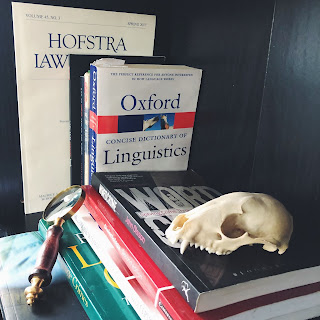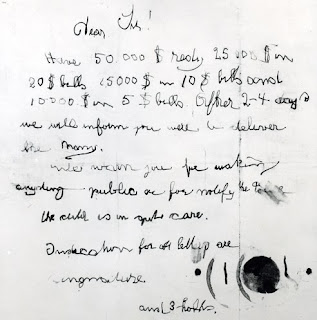Analysis vs Identification
One of the first things I learned in studying Forensic Linguistics is that I should never say I have "identified" the author or speaker of my language evidence. That advice comes from a scientist who has investigated several murders. As Dr. Leonard explains it: Even if you have enough evidence to implicate a single suspect, there's still a chance that among the seven billion humans in the world, one of them might happen to use language in the exact same way as your suspect. There's no room for that "scientific certainty" bullshit in his department. The goal of Forensic Linguistic investigation, rather, is to determine the probable creator(s) of language evidence. As an investigator, I would only say, based on the language examined, which suspect(s) I might interpret to be its most likely creator. Maybe even least likely creator, if it's an Authorship Attribution case.
All of this hedging - avoidance of certainty or commitment - is intentional. I've taken this advice to heart, and you can see it in my posts, where I use a lot of maybe's and likely's and probable's. In writing this very blog, stating anything about Forensic Linguistics as a fact makes me nervous of misrepresenting my interpretation as truth. While being wrong on my blog will embarrass my professors at worst, much bigger things are at stake in the justice system; sometimes even lives. Often money, but also lives. I, for one, do not want to be the investigator who was so confidently wrong that someone dies.
This philosophy of mitigation inspired my thesis method's title: Native Language Analysis. The term "identification" implies discovery or pinpointing. Conversely, "analysis" is a process; the detailed examination of something for its elements and components. My Native Language Analysis will be a process of examining language samples for inter-language transfer features and connecting those features to possible source languages. It will be a process of analyzing evidence and data. Ultimately, it will be up to the individual linguist to interpret their own results. Even in theory, I will not say that one could identify, with absolute certainty and without doubt, every native language that influences every sample of second-language English.
A lot of methods in Forensic Linguistics are called analysis, or something to that effect. So, going forward, when I differentiate my thesis research as Native Language Analysis, I am trying to further divorce it from Native Language Identification. While I am relying heavily on results from Native Language Identification (NLID), its methods (and modern computational technology) are not suitable for Forensic Linguistic investigation. Furthermore, a lot of NLID research is aiming for automated native language detection, which I do no believe will ever be suitable for criminal investigations. Native Language Analysis, then, is my attempt to adapt NLID findings to Forensic Linguistics; preferably for more immediate application in investigations.
All of this hedging - avoidance of certainty or commitment - is intentional. I've taken this advice to heart, and you can see it in my posts, where I use a lot of maybe's and likely's and probable's. In writing this very blog, stating anything about Forensic Linguistics as a fact makes me nervous of misrepresenting my interpretation as truth. While being wrong on my blog will embarrass my professors at worst, much bigger things are at stake in the justice system; sometimes even lives. Often money, but also lives. I, for one, do not want to be the investigator who was so confidently wrong that someone dies.
This philosophy of mitigation inspired my thesis method's title: Native Language Analysis. The term "identification" implies discovery or pinpointing. Conversely, "analysis" is a process; the detailed examination of something for its elements and components. My Native Language Analysis will be a process of examining language samples for inter-language transfer features and connecting those features to possible source languages. It will be a process of analyzing evidence and data. Ultimately, it will be up to the individual linguist to interpret their own results. Even in theory, I will not say that one could identify, with absolute certainty and without doubt, every native language that influences every sample of second-language English.
A lot of methods in Forensic Linguistics are called analysis, or something to that effect. So, going forward, when I differentiate my thesis research as Native Language Analysis, I am trying to further divorce it from Native Language Identification. While I am relying heavily on results from Native Language Identification (NLID), its methods (and modern computational technology) are not suitable for Forensic Linguistic investigation. Furthermore, a lot of NLID research is aiming for automated native language detection, which I do no believe will ever be suitable for criminal investigations. Native Language Analysis, then, is my attempt to adapt NLID findings to Forensic Linguistics; preferably for more immediate application in investigations.


Comments
Post a Comment